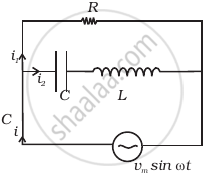Advertisements
Advertisements
प्रश्न
In a series LCR circuit connected to an a.c. source of voltage v = vmsinωt, use phasor diagram to derive an expression for the current in the circuit. Hence, obtain the expression for the power dissipated in the circuit. Show that power dissipated at resonance is maximum
उत्तर
The phasor diagram for the series LCR circuit is

The phasor relation for the voltages is
VL + VR + VC = V
Because VC and VL are always along the same line and in opposite directions, they can be combined into a single phasor (VC + VL) which has a magnitude |vCm - vLm|.
Because V is represented as the hypotenuse of a right triangle whose sides are VR and (VC + VL), the Pythagorean theorem gives
`v_m^2=v_(Rm)^2+(V_(Cm)-V_(Lm))^2`
`:.v_m^2=(i_mR)^2+(i_mX_c-i_mX_L)^2`
`:.v_m^2=i_m^2[R^2+(X_C-X_L)^2]`
`:.i_m=v_m/sqrt(R^2+(X_C-X_L)^2)`
This is the expression for the current in the circuit.
The instantaneous power in the circuit is
P = vi = (vmsinωt)(imsin(ωt+Φ))
`:. P=(v_mi_m)/2(sinomegat)(sin(omegat+phi))`
`:.P=(v_mi_m)/2(cosphi-cos(2omegat+phi))`
The average power over a cycle is given by the average of the two terms in the RHS of the above equation.
It is only the second term (cos(2ωt+)) which is time-dependent. Its average is zero. Therefore, we get
`P=(v_mi_m)/2cosphi=v_m/sqrt2xxi_m/sqrt2cosphi`
∴ P = VI cosΦ
It can also be written as P = I2ZcosΦ
At resonance XC − XL = 0 and Φ = 0. Therefore, cosΦ = 1 and power is P=I2Z=I2R.
That is, maximum power is dissipated in a circuit at resonance.
APPEARS IN
संबंधित प्रश्न
In a series LCR circuit, obtain the condition under which the impedance of the circuit is minimum ?
A coil having an inductance L and a resistance R is connected to a battery of emf ε. Find the time taken for the magnetic energy stored in the circuit to change from one fourth of the steady-state value to half of the steady-state value.
Two coils A and B have inductances 1.0 H and 2.0 H respectively. The resistance of each coil is 10 Ω. Each coil is connected to an ideal battery of emf 2.0 V at t = 0. Let iA and iBbe the currents in the two circuit at time t. Find the ratio iA / iB at (a) t = 100 ms, (b) t = 200 ms and (c) t = 1 s.
Answer the following question.
In a series LCR circuit connected across an ac source of variable frequency, obtain the expression for its impedance and draw a plot showing its variation with frequency of the ac source.
Answer the following question.
What is the phase difference between the voltages across the inductor and the capacitor at resonance in the LCR circuit?
For a series LCR-circuit, the power loss at resonance is ______.
Consider the LCR circuit shown in figure. Find the net current i and the phase of i. Show that i = v/Z`. Find the impedance Z for this circuit.

An alternating voltage of 220 V is applied across a device X. A current of 0.22 A flows in the circuit and it lags behind the applied voltage in phase by π/2 radian. When the same voltage is applied across another device Y, the current in the circuit remains the same and it is in phase with the applied voltage.
- Name the devices X and Y and,
- Calculate the current flowing in the circuit when the same voltage is applied across the series combination of X and Y.
When an alternating voltage of 220V is applied across device X, a current of 0.25A flows which lags behind the applied voltage in phase by π/2 radian. If the same voltage is applied across another device Y, the same current flows but now it is in phase with the applied voltage.
- Name the devices X and Y.
- Calculate the current flowing in the circuit when the same voltage is applied across the series combination of X and Y.
A series LCR circuit is connected to an ac source. Using the phasor diagram, derive the expression for the impedance of the circuit.
